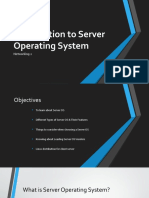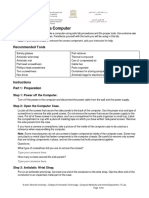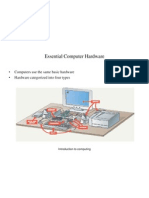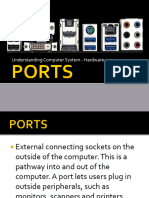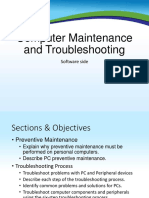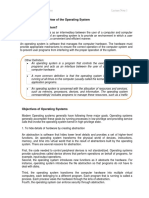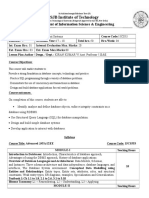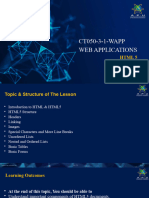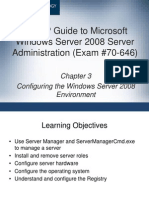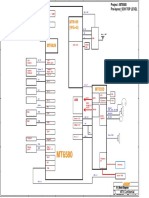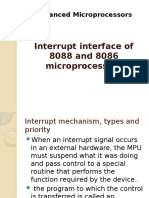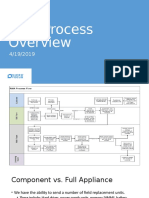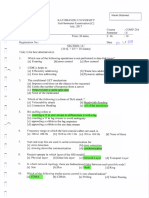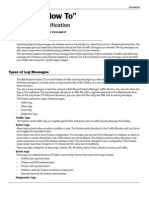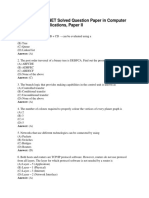Microsoft Windows Server
Chapter 1
Introduction to Windows Server
� Clients, Servers, and Windows
Network Models
• Workgroup
– Network of computers that allow each other access to
their files, printers, or Internet connection
• By default, all Windows Server computers are placed
in a workgroup named WORKGROUP
• Membership status
– Either a single workgroup or a domain
2
� Domain Model with Active Directory
• Domain
– Group of users and computers managed by the same
security database
• Active Directory Domain Services (AD DS)
– Technology that runs the domain security database
• Domain controllers (DCs)
– Servers that hosts domain security database
• Domain Name System (DNS)
– TCP/IP-based standard for resolving computer names
with IP addresses
3
� Domain Model with Active Directory
(continued)
• Group Policy
– A way to set up specific configurations for users and computers
within an Active Directory domain.
– GP settings are contained in Group Policy objects (GPOs)
• Forest
– A network of domains related to each other by relationships
known as trusts
• us.microsoft.com and microsoft.com
• Transitive trusts
– Trusts between Active Directory domains in a tree are created
automatically when you create domains
• BenderTechnology.com and BenderResources.com.
4
� Windows Server Editions
• General editions of Windows Server
– Enterprise, Datacenter, and Standard
– Editions designed for special-purpose server
applications
• Web Server and HPC Server
5
� Windows Server, Standard Edition
• Designed for smaller environments and single-
purpose installations
• Works as a single domain server for a small
business or
– A single file/application server in larger environments
6
� Windows Server, Enterprise Edition
• Features not available with SE
– Significant increase in maximum allowable memory
– Active Directory Federation Services
– Failover clustering
– Installation of up to four virtual machines on each
physical host
– Hot-add memory
7
� Windows Server, Datacenter Edition
• Additional features
– Ability to hot-add and replace processors
– Installation of unlimited virtual machines on each
physical host
8
� Windows Web Server
• Server roles not available
– Dynamic Host Configuration Protocol (DHCP)
– DNS, File server
• Does not require client access licenses (CAL) for
users
9
� Windows Server Hyper-V
• Hyper-V
– Consolidates multiple server roles as separate virtual
machines running on a single physical machine
– Lets you efficiently run different operating systems in
parallel on a single server
10
� New Technologies in Windows Server
• Technologies and enhancements
– Improved installation process
– Hyper-V
– Server Core
– TCP/IP improvements
– Network Access Protection
– Server Manager
– Windows Remote Management
– PowerShell
– Group Policy preferences
11
� Improved Installation Process
• Requires minimal user input
• You no longer have to wait for the installation
program to ask for information
– Networking information, regional settings, and other
settings
12
� Hyper-V
• Virtualization
– Allows you to run one or more separate instances of
an OS within a single host OS
– Allows organizations to consolidate these physical
systems onto high-powered servers
13
� Server Core
• A stripped-down installation of Windows Server with
a set of available roles and services more limited
than in the Full version
• Attack surface
– Areas of the system that could expose it to security
breaches
• Can be installed on Standard, Enterprise, and
Datacenter editions of Windows Server
– But only during initial installation of the operating
system
14
� Network Access Protection
• A Windows platform that helps to protect networks,
both public and private, from malware such as
viruses and spyware
• Threat sources
– Employees accessing the Internet from work and
inadvertently install Trojan horses
– Remote access to connections from external networks
that create a gateway for viruses
– Guest computers accessing an internal network that
introduce malware to the network
15
� TCP/IP Improvements
• Next-Generation TCP/IP stack
– New implementation of the TCP/IP protocol stack
– Contains full support for IPv4 and IPv6
• Teredo
– IPv6 technology that can encapsulate IPv6 packets as
IPv4 packets to allow them to traverse IPv4 networks
• Receive Window Auto-tuning
– Optimizes the size of data packets a server can
accept
16
� Server Manager
• Centralizes commands to configuration tools
• Allows you to easily manage your server and
network
17
�18
� PowerShell
• Now becoming the de facto CLI and scripting
language for Microsoft products
• Allows you to string together commands, passing the
result of one command into the next, in a process
known as pipelining
• Passes results as .NET objects
19
�20
� Windows Remote Management
• Lets administrators manage servers remotely by
running management scripts and managing data on
remote machines
• WS-Management protocol
– Public standard for exchanging management data
remotely by any device implementing the protocol
21
� Group Policy Preferences
• It is new feature of the Group Policy Management
Console (GPMC)
• Applied but not enforced
• Helps to implement Group Policies within your Active
Directory environments
22
� Roles and Features in Windows
• Role
– Major function or service that a server performs
– Example: File Services role
• Allows the server to share files on a network
23
� Roles in Server
• Server role
– Defines the specific task that a server is responsible
for performing
• Roles can be organized into three groups
– Active Directory
– Infrastructure
– Network roles
24
�25
� Active Directory Roles
• Provide an integrated way to manage resources,
both internal and external.
• Windows Server includes five Active Directory roles
– Active Directory Certificate Services
– Active Directory Domain Services
– Active Directory Federation Services
– Active Directory Lightweight Directory Services
– Active Directory Rights Management Services
26
� Active Directory Certificate Services
• It provides digital certificate services for users,
computers, and organizations. As a security
technology, it provides customizable services for
creating and managing public key certificates used in
software security systems that employ public key
technologies.
27
� Active Directory Domain Services
• AD DS stores information on objects such as users
and groups on the network.
• This information is available so users can effectively
access resources on the network and collaborate
with other users.
28
� Active Directory Federation Services
• A secure framework for allowing simplified identity
federation and single sign-on for Web services, both
internal and external.
29
� Active Directory Lightweight Directory
Services
• Used to deploy directory-enabled applications,
without the dependencies that are required for AD
DS.
• Allows you to create and manage computer, user,
and group objects that applications can use with a
DC.
30
� Active Directory Rights Management
Services
• Used to deploy rights technologies to your network.
• Used in connection with rights management-aware
applications and clients such as Microsoft Office
2007 and Windows Vista, users and administrators
can protect intellectual property and data within an
organization.
31
� Network Roles
• Cover the major networking protocols and services
• Three Active Directory Network roles
– DHCP
• Network standard protocol used to dynamically allocate and track IP
addresses for clients on a network
– DNS
• Main goal is to match a domain name to an IP address based on a
client query for information
– Network Policy and Access Services (NPAS)
• It provides networking technologies for deploying virtual private
networking, dial-up networking, and 802.11-protected wireless
access
• Allows you to implement
– Network Policy Server
– Routing and Remote Access Service
– Health Registration Authority
– Host Credential Authorization Protocol
32
� Infrastructure Roles
• It provide the major services for clients.
• Active Directory roles that can be installed in Server
– Terminal Services
• Provides technologies that enable users to access Windows
programs that are installed on a terminal server
– Fax Services
• Allows administrators to create a fax gateway on their
network.
– Print Services
• Allows you to create networked printer resources for clients.
33
� Infrastructure Roles
– File Services
• Allows you to share and manage file resources on a network.
– Hyper-V
• It allows you to deploy multiple virtual machine instances, or
guests, within a single Windows Server 2008 server
– UDDI (Universal Description Discovery, and
Integration) Services
• Are an industry specification for publishing and locating
information about Web services.
– Web Server (IIS 7)
• The latest version of a Web services platform from Microsoft.
– Windows Deployment Services
• The updated and reengineered implementation of Remote
Installation Services
34
� New Features
• Feature
– Similar to a job responsibility performed by a specific
role
• Features available in Server
– .NET 3.0 Framework
– Windows Desktop Experience
– Network Load Balancing
– Group Policy Management
– Remote Server Administration Tools
– Windows PowerShell
– Windows Server Backup Features
35
� Roles and Features Management
• Server Manager console and Server Manager
command-line utility
– Used to manage roles and features
• Major areas of information within Server Manager
– Server Summary
– Roles
– Features
– Diagnostics
– Configuration
– Storage
36
� Network and Sharing Center
• Provides a central location for administering many
network tasks in Windows Server, including:
– Network connections
– Sharing settings
– Network discovery options
37
�38
� Windows Desktop Experience
• Applications
– Windows Mail
– Windows Media Player
– Windows Aero and other desktop themes
– Video for Windows (AVI support)
– Windows Photo Gallery
– Windows SideShow
– Windows Defender
39
� Summary
• Most modern networks are based on client-server
computing
• Windows Server offers three general editions and
two special-purpose editions
– Windows Server Standard
– Windows Server Enterprise
– Windows Server Datacenter
– Windows Web Server
40
� Summary (continued)
• Windows Server
– Available for both 32-bit and 64-bit hardware
architectures
• New technologies in Windows Server
– Focus on improving the performance, manageability,
and security of networks
• Windows Server
– Lets you organize server services into roles and
features
41
� Summary (continued)
• Server Manager
– Provides administrators with a GUI console for
managing roles and features
42
